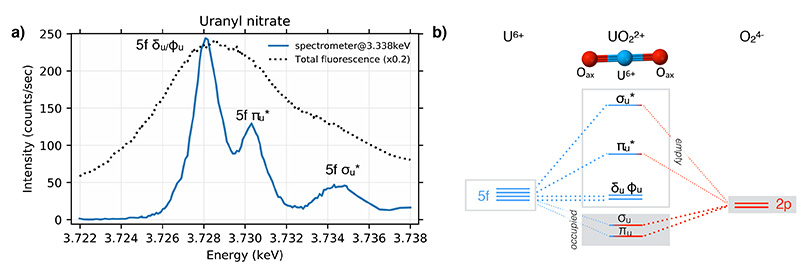MARS beamline offers its users a new experimental technique: High-Energy Resolution Fluorescence-Detection (HERFD) X-ray Absorption Spectroscopy (XAS)
Context and experimental challenges
The physical properties and reactivity of actinide elements (in particular uranium) are highly dependent on their electronic structure and more specifically the 6d and 5f valence orbitals. X-ray absorption spectroscopy (XAS) can be used to probe the electronic structure of these orbitals and determine the degree of oxidation and the local atomic structure of actinides. XANES/EXAFS spectroscopy at actinide L3 edges (for uranium: 17.2 keV) can be used to probe 6d orbitals (2p core hole) and is routinely used on the MARS beamline, which is dedicated to the study of radioactive materials. 5f orbitals can be probed at the M4,5 edges (3d core hole), which energy (3.7 keV for uranium) presents a double challenge: it is the lower bound of the MARS beamline energy range (3.5 keV) and in regard to these energies air scattering dramatically reduces the incident and detected photon flux. Furthermore a crystal-analyzer spectrometer must be used to determine the detailed structure of the 5f orbitals. This reduces the flux of the detected photons by 2 or 3 orders of magnitude, and increases up to 2m the x-ray path in the air, while 10 cm of air induces already a photon flux reduction by a factor of 10!
First U M4 spectra on MARS
In February 2018, uranium M4 edge XANES was performed for the first time on the MARS beamline. Helium chambers were used to minimize as much as possible the presence of air on the X-ray path. The MARS beamline emission spectrometer equipped with a Si(220) bent crystal analyzer made it possible to detect the Mbeta emission with a resolution of 1.6 eV.
Figure 1a compares the uranium M4 edge spectra of uranyl nitrate measured in total fluorescence yield using a SDD detector and using the emission spectrometer. This technique is called high-energy resolution fluorescence-detection (HERFD) XAS because the detection of the Mbeta fluorescence line with an energy resolution in the order of the electron-volt reduces effectively the 3d core-hole lifetime broadening. In the case of uranyl nitrate, three absorption bands can be distinguished that correspond to the three groups of non-bonding and anti-bonding 5f molecular orbital groups formed in the uranyl bond (see Figure 1b).

Figure 1: a) HERFD-XAS spectra at the uranium M4 edge in uranyl nitrate. b) Simplified molecular orbital diagram of uranyl.
Importance for the study of actinyls
Among the different chemical forms of actinides (An), hexavalent trans-dioxo AnO22+ linear groups called actinyls (uranyl for uranium) are of particular interest. Effectively, the reactivity of these species is a crucial factor for many applications in medical, nuclear and environmental chemistry. In addition to its technological and environmental importance, uranium is a model element in the actinide family. In ambient oxidation-reduction conditions, it occurs mainly as hexavalent uranyl bipyramids with a variable number of equatorial oxo-ligands, resulting in more than 300 natural or synthetic crystal structures.
The reactivity of uranyl ions, and hence their mobility, depends on the reactivity of the equatorial ligands and is revealed in the covalency of the uranyl bond. This covalency is governed by the location of the uranium 5f electrons, which can be probed using M-edge HERFD-XAS spectroscopy.
Conclusion
The recent availability of actinide M4,5 edge HERFD-XAS on the MARS beamline opens up numerous opportunities for physicochemical research on these elements, while also benefiting from the radioprotection conditions offered by the MARS beamline.
